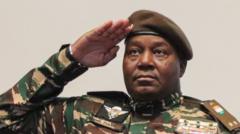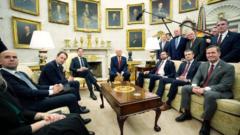A group chat involving US officials discussing imminent airstrikes on Yemen was leaked, prompting debates on classification status and the implications of shared tactical information. Experts weigh in on the potential risks and fallout from the revelations.
Unraveled Secrets of US Operations in Yemen: Signals from a Leaked Chat

Unraveled Secrets of US Operations in Yemen: Signals from a Leaked Chat
A recently leaked chat reveals sensitive details about US military actions in Yemen, raising questions around classified information and operational security.
In a turn of events that has sent shockwaves through the intelligence community, a leaked Signal group chat among high-ranking US security officials has unveiled critical insights into military operations in Yemen. Originally published by the Atlantic magazine, the exchange came to light after editor-in-chief Jeffrey Goldberg mistakenly became part of the conversation, prompting further scrutiny of the disclosed information. Following assurances that no classified data was included, Goldberg shared the chat's content, leading to widespread analysis and discussion.
One particularly sensitive aspect of the conversation details the timeline for proposed US air strikes against Houthi targets in Yemen. These messages describe the planned launch times of F-18 fighter jets alongside "trigger-based" criteria for executing attacks—data that former NSA counsel Glenn Gerstell argues should be considered highly classified. The specificity of such details raises concerns about operational security, with military experts emphasizing the potential risk of exposing tactical movements.
One striking message from National Security Advisor Mike Waltz details the aftermath of a strike on a target identified as a Houthi missile operative at his girlfriend's residence, which he confirmed had been successfully struck. While military evaluations refer to these insights as battle damage assessments (BDA), questions linger about the methods used to track the target's movements. Analysts suggest that such intelligence could stem from a combination of aerial surveillance and human intelligence.
On a broader strategic front, Joe Kent, a former special ops officer, alludes to operational coordination with Israel, which has conducted its own airstrikes against Houthi positions in retaliation for missile attacks. His commentary raises intense debate over international intelligence sharing and the implications for regional security dynamics. CIA Director John Ratcliffe augmented this by discussing the mobilization of intelligence assets in Yemen, underscoring the precarious nature of classified operational information.
As reactions to the leaked chat continue to develop, many experts express concerns over the risks posed by revealing sensitive military information in an age of information warfare. The fallout from these revelations will likely echo through both domestic and international circles as the White House navigates the complexities of military transparency and national security.






















